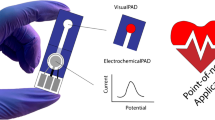Abstract
Methyl parathion hydrolase (MPH) is an enzyme that catalyzes the degradation of methyl parathion, generating a yellow product with specific absorption at 405 nm. The application of MPH as a new labeling enzyme was illustrated in this study. The key advantages of using MPH as a labeling enzyme are as follows: (1) unlike alkaline phosphatase (AP), horseradish peroxidase (HRP), and glucose oxidase (GOD), MPH is rarely found in animal cells, and it therefore produces less background noise; (2) its active form in solution is the monomer, with a molecular weight of 37 kDa; (3) its turnover number is 114.70 ± 13.19 s−1, which is sufficiently high to yield a significant signal for sensitive detection; and (4) its 3D structure is known and its C-terminal that is exposed to the surface can be easily subjected to the construction of genetic engineering monocloning antibody–enzyme fusion for enzyme-linked immunosorbent assay (ELISA). To demonstrate its utility, MPH was ligated to an single-chain variable fragment (scFv), known as A1E, against a white spot syndrome virus (WSSV) with the insertion of a [–(Gly–Ser)5–] linker peptide. The resulting fusion protein MPH-A1E possessed both the binding specificity of the scFv segment and the catalytic activity of the MPH segment. When MPH-A1E was used as an ELISA reagent, 25 ng purified WSSV was detected; this was similar to the detection sensitivity obtained using A1E scFv and the HRP/Anti-E Tag Conjugate protocol. The fusion protein also recognized the WSSV in 1 μL hemolymph from an infected shrimp and differentiated it from a healthy shrimp.

The 3-D structure of MPH. (a) monomer showing C- and N-terminals; (b) the crystal structure of the dimer








Similar content being viewed by others
References
Nakane PK, Pierce GBJ (1966) J Histochem Cytochem 14:929–931
Renz M, Kurz C (1984) Nucleic Acids Res 12:3435–3444
Gretch DR (1997) Hepatology 26:43S–47S
Gabaldon J, Maquieira A, Puchades R (1999) Crit Rev Food Sci Nutr 39:519–538
Karl S (2001) J Biotechnol 85:149–173
Sharpe M (2003) J Environ Monit 5:109N–113N
Willner I, Basnar B, Willner B (2007) FEBS J 274:302–309
Porstmann T, Kiessig ST (1992) J Immunol Methods 150:5–21
Avrameas S (1969) Immunochemistry 6:43–48
Nakane PK, Kawaoi A (1974) J Histochem Cytochem 22:1084–1091
Kato K, Hamaguchi Y, Fukui H, Ishikawa E (1975) J Biochem (Tokyo) 78:235–237
Uto I, Ishimatsu T, Hirayama H, Ueda S, Tsuruta J, Kambara T (1991) J Immunol Methods 138:87–94
Lindbladh C, Mosbach K, Bulow L (1993) Trends Biochem Sci 18:279–283
Carrier A, Ducancel F, Settiawan NB, Cattolico L, Maillere B, Leonetti M, Drevet P, Menez A, Boulain JC (1995) J Immunol Methods 181:177–186
Zhan WB, Chen J, Zhang ZD, Zhou L, Fukuda H (2003) Dis Aquat Org 53:263–265
Zhan WB, Wang XJ, Chen J, Xing J, Fukuda H (2004) Aquaculture 239:15–21
Chen YL, Zhang XE, Liu H, Wang YS, Xia XM (2002) Acta Microbiol Sin 42:490–497
Sun L, Dong YJ, Zhou YF, Yang MJ, Zhang CG, Rao ZH, Zhang XE (2004) Acta Crystallogr D 60:954–956
Dong YJ, Bartlam M, Sun L, Zhou YF, Zhang ZP, Zhang CG, Rao ZH, Zhang XE (2005) J Mol Biol 353:655–663
Chu XN, Zhang XE, Chen YL, Liu H, Sun DL (2003) Acta Microbiol Sin 43:453–458
Dai HP, Gao H, Zhao XY, Dai LF, Zhang XK, Xiao N, Zhao RH, Hemmingsen SM (2003) J Immunol Methods 279:267–275
Shao WH, Zhang XE, Liu H, Zhang ZP (2000) Bioconj Chem 11:822–826
French C, Keshavarz-Moore E, Ward JM (1996) Enzyme Microb Technol 19:332–338
Schuck P (2000) Biophys J 78:1606–1619
Chaudhry GR, Ali AN, Wheeler WB (1988) Appl Environ Microbiol 54:288–293
Cui ZL, Li SP, Fu GP (2001) Appl Environ Microbiol 67:4922–4925
Zhang RF, Cui ZL, Zhang XZ, Jiang JD, Gu JD, Li SP (2006) Biodegradation 17:465–472
The WHO recommended classification of pesticides by hazard and guidelines to classification 2004, International Programme on Chemical Safety, Geneva
Acknowledgement
This work was supported by 863 project (No. 2006AA020904).
Author information
Authors and Affiliations
Corresponding author
Additional information
W. Yang and Y.-F. Zhou contributed equally to this work.
Rights and permissions
About this article
Cite this article
Yang, W., Zhou, YF., Dai, HP. et al. Application of methyl parathion hydrolase (MPH) as a labeling enzyme. Anal Bioanal Chem 390, 2133–2140 (2008). https://doi.org/10.1007/s00216-008-1987-y
Received:
Revised:
Accepted:
Published:
Issue Date:
DOI: https://doi.org/10.1007/s00216-008-1987-y




